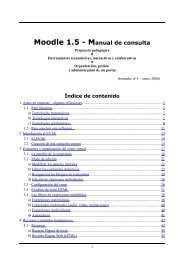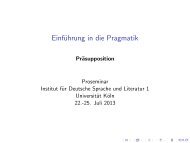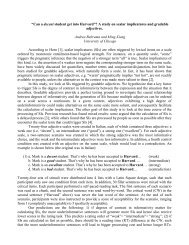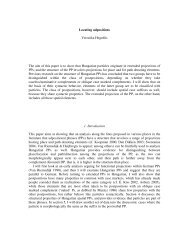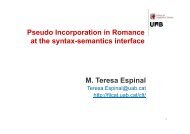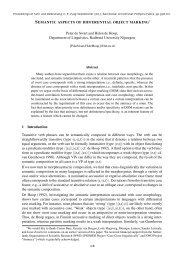slides - corpora@parles.upf - Universitat Pompeu Fabra
slides - corpora@parles.upf - Universitat Pompeu Fabra
slides - corpora@parles.upf - Universitat Pompeu Fabra
You also want an ePaper? Increase the reach of your titles
YUMPU automatically turns print PDFs into web optimized ePapers that Google loves.
A Parametric Account of Chinese and<br />
English Synthetic Compounds<br />
Xuhui Freddy Hu<br />
Department of Theoretical and Applied Linguistics<br />
University of Cambridge<br />
<br />
JeNom 5, <strong>Universitat</strong> <strong>Pompeu</strong> <strong>Fabra</strong>, 21/07/2013
1 Chinese Syn-Compounds: Data & Issues<br />
a. The unavailability of the nominalizing functors<br />
(1) English Syn-Compound:<br />
Truck repairing<br />
(2) Chinese Syn-Compound:<br />
Qi-che xiu-li<br />
Truck repair<br />
‘truck repairing’
1 Chinese Syn-Compounds: Data & Issues<br />
b. Compatibility with the external argument,<br />
contra Roeper and Siegel (1978), Selkirk<br />
(1982), Borer (2012, forthcoming)<br />
(3) English Syn-Compounds:<br />
truck driving VS. *man driving (of trucks)<br />
(4) Chinese Syn-Compounds:<br />
Qi-che xiu-li VS. Xiaowang xiu-li<br />
Truck repair VS. Xiaowangrepairing<br />
‘truck repairing’ ‘repairing conducted by<br />
Xiaowang’
1 Chinese Syn-Compounds: Data & Issues<br />
c. Word order<br />
Unlike the English Syn-Compounds, which invariably<br />
exhibit the N-V order, Chinese have two orders, N-V and V-<br />
N:<br />
(6) V-N order<br />
Xiu che xiu che gong<br />
Repair truck<br />
repair truck labourer<br />
‘trucking repairing’ ‘truck repairer’
1 Chinese Syn-Compounds: Data & Issues<br />
d. Optional ORIGINATOR interpretation<br />
Borer (2012, forthcoming) points out that for the<br />
English ING Syn-Compounds, if the non-head is the<br />
internal argument of verb, then the verb should have a<br />
transitive reading. But this is not the case in Chinese:<br />
(7) No one knows when the boat sinking happened.<br />
(8) Ta jingli guo chen chuan<br />
he experience Perf. sink boat<br />
‘He once experienced the sinking of the boat’ (the<br />
boat either sank by itself or was sunk by someone.)
2 The Theoretical Framework <br />
Borer’s (forthcoming) XS model is taken in this<br />
research. The following points are relevant to our<br />
purpose:<br />
2.1 The function of C(ategorial)-functors<br />
Lexical items are only phonological indices with no<br />
categorial features (thus are “roots”), and the C-functor<br />
plays the role of providing categories to the roots. The<br />
root can take categories via two ways.<br />
The first way is to take a C-functor. For example,<br />
beautiful is an adjective due to its C A -functor “ful”.
2 The Theoretical Framework <br />
The second way is to resort to the Category<br />
Complement Set (CCS). A C-functor projects a syntactic<br />
node, which divides a categorial space (CCS). A root<br />
will get a corresponding categorial value due to the<br />
CCS determined by the C-functor. For example, the C-<br />
functor ING will on the one hand project a N node,<br />
which means that the output of the syntactic<br />
computation from this projection will take a N category,<br />
and also, it will define a V type CCS, which basically<br />
means that the item put in the CCS takes a V category.
2 The Theoretical Framework <br />
ING is thus put as ING N (V). Two possibilities will occur for the<br />
derivation to converge: firstly, an item with a C V -functor will be<br />
qualified. For example, enable takes a C V -functor en, and can be<br />
merged in the complement of ING N (V) . Secondly, an acateogrial root<br />
can be merged in the complement position, and in this case, the<br />
syntactic environment will make this root V-equivalent, that is, this<br />
root will take a V category:<br />
<br />
Borer (forthcoming)
2 The Theoretical Framework <br />
2.2 On Syn-Compounds<br />
Borer argues that the Syn-Compound is in nature identical like other<br />
simple event nominals (R-Nominal) such as class, lecture, etc. This<br />
type of compound is formed via two steps: N and V are combined first,<br />
and then the non-head part N is moved to the left side of V, so that V<br />
can combine with the C-functor (ING/ER), with the whole compound<br />
being nominalised.<br />
Borer also assumes that ING/ER in Syn-Compounds take an<br />
ORIGINATOR function, which explains why when the non-head part of<br />
the compound is taken as the internal argument of the verb, the verb<br />
has to be transitive.
3 Accounting for Chinese Syn-Compounds<br />
3.1 The N-V type<br />
The two issues have to be explained. The first one is how<br />
Chinese Syn-Compounds are nominalised, considering that<br />
there is no ING type nominaliser in Chinese.<br />
Follwoing Borer’s XS model we assume that Chinese roots<br />
are categorised in the relevant syntactic environment. For<br />
example, a root will become A(or ADV)-equivalent when<br />
preceded by hen (very), N-equivalent in [Spec TP] or<br />
complement of V , and V-equivalent in the complement of<br />
little v (or complement of Asp in Borer (2005a,b)) .
3.1 The N-V type<br />
This predicts that a root might have different<br />
categories, in line with the real data in Chinese:<br />
(9) Tade fengge hen Jay Chou.<br />
His style very Jay Chou<br />
‘His style is very much of Jay Chou’s type.’<br />
(10) zhebu dianying hen da (Chinese Wu dialect).<br />
This movie very fight.<br />
‘This movie is full of fighting.’
3.1 The N-V type<br />
Unlike English which takes ING to provide the N<br />
category, Chinese Syn-Compounds get their<br />
categories from their syntactic positions, such as<br />
[Spec TP] and the complement of V:<br />
(11) ta meitai douzai gao qi-che xiu-li.<br />
He every day always do truck repair.<br />
‘Every day, he is engaged in truck repairing.’
3.1 The N-V type<br />
Another issue is the ‘compatibility with the external<br />
argument’.<br />
Borer’s analysis implies that interpretation is from the<br />
language-specific affix ING, not from the abstract and<br />
perhaps universal structure of Syn-Compounds.<br />
Since Chinese Syn-Compounds are categorised in the<br />
syntactic environment, not from C-functors, the immediate<br />
consequence then is that no obligatory ORIGINATOR<br />
interpretation is required.
3.2 The V-N Type Compound <br />
A question to be addressed:<br />
If roots can get their categories from the syntactic<br />
environment, why are C-functors required anyway?<br />
A theoretical foundation:<br />
Only those lexical items with independent phonological<br />
forms can attain content via encyclopedia search (ensearch)<br />
(Borer forthcoming).<br />
So if a root has no independent phonological form, it can<br />
only appear with a C-functor to take a full phonological<br />
realization, with content being assigned via en-search.
3.2 The V-N Type Compound <br />
(12) A tentative parameter of roots:<br />
The language on the end of extreme syntheticity does<br />
not have roots with independent phonological<br />
realizations; the roots of the language on the end of<br />
extreme analyticity always have independent<br />
phonological realizations.
3.2 The V-N Type Compound <br />
(12) predicts that<br />
ª in a highly synthetic language, the root has to take<br />
a C-functor, because the lack of the independent<br />
phonological realization will block the en-search of the<br />
root for content;<br />
ª in a highly analytical language like Chinese, a root<br />
can be categorised without a C- functor, because<br />
the root already has independent phonological<br />
realization, thus C-functors are not necessarily needed;<br />
ª if a language is in between the two ends of the<br />
parameter, only some roots can realise different<br />
categorial features, confirmed by the data in English.
3.2 The V-N Type Compound <br />
The parameter in (12) also predicts that root<br />
incorporation is productive in Chinese, with the<br />
perspective of head movement in Roberts (2010).<br />
<br />
(13) Head Movement Conditions <br />
X and Y are minimal categories.<br />
The features of Y are a proper subset of the features<br />
of X.<br />
Roberts (2010)<br />
Head movement and incorporation also take place if<br />
neither X nor Y has feature, which is the case of<br />
roots.
3.2 The V-N Type Compound <br />
So we assume a new root can be created via root<br />
incorporation with the following conditions:<br />
a. The root in Chinese has independent phonological<br />
realization and thus can provide content for further<br />
content combination.<br />
b. Roots in general have no categorial feature.<br />
ROOT+ROOT = A New ROOT
3.2 The V-N Type Compound <br />
The new root has the following properties:<br />
a. Its content is based on the combination of the content<br />
of the atomic roots.<br />
b. Its content is not a sole result of the content<br />
combination, but can have idiosyncratic meaning via ensearch<br />
c. There is no clear boundary between the two atomic<br />
root (i.e. we can’t determine which is head or non-head, it<br />
is indivisible)<br />
d. The syntactic (or perhaps morphological ) rules in the<br />
sense of Roeper (1999), Ackema & Neeleman (2004) etc.<br />
involved in compounding do not hold in root incorporation.
3.2 The V-N Type Compound <br />
Examples:<br />
(14)a. Qiu zheng zhejian shiqing<br />
seek proof this fact<br />
“prove this fact”<br />
b. he jiu (Chinese Wu dialect)<br />
drink wine<br />
‘attend a wedding ceremony’
3.2 The V-N Type Compound <br />
Why are the N-V type Syn-Compounds still attested?<br />
Both N and V in this type consist of two roots, i.e. both<br />
N and V are the result of root incoporation.<br />
We assume recursive root incorporation is banned. So<br />
when the N and V are the outcome of root<br />
incorporation, the other way is to resort to the strategy<br />
of N-V compounding, which is also allowed by the<br />
syntactic principles.
Conclusion <br />
ª All the variation can be reduced to a single factor: the status of the<br />
root, which is accompanied with the availability of C-functors.<br />
ª Chinese roots always have independent phonological realization,<br />
and thus can be categorially valued in syntactic environment<br />
without resorting to C-functors.<br />
ª The lack of ING C-functor thus explains the optional<br />
ORIGINATOR interpretation.<br />
ª A new lexical ROOT can be formed whose content is attained via<br />
en-search based on the combination of the roots’ contents, and<br />
syntactically acategorial nature of the roots enables the head<br />
movement and incorporation. This explains why Chinese has the<br />
V-N type Syn-Compounds.<br />
ª This analysis is also in line with the general spirit of Borer-<br />
Chomsky Conjecture (Baker 2008), and the “Hierarchy of<br />
Parameters” in the sense of Roberts & Holmberg (2010).
References<br />
Ackema, P. & A. Neeleman (2004) Beyond Morpology. Oxford: OUP.<br />
Baker, M. (2008) The syntax of agreement and concord. Cambridge: Cambridge<br />
University Press.<br />
Borer, H. (2005a) Structuring Sense, Vol. 1. In Name Only. Oxford: OUP.<br />
Borer, H. (2005b) Structuring Sense, Vol. 2. The Normal Course of Event. Oxford: OUP.<br />
Borer, H. (forthcoming) Structuring Sense, Vol 3. Taking Form. Oxford: OUP<br />
Roberts, I. (2010) Agreement and Head Movement: Clitics, Incorporation and Defective<br />
Goals. Cambridge, Mass.: MIT Press. <br />
Roberts, I. & A. Holmberg (2010) Introduction. In T. Biberauer, A. Holmberg, I. Roberts &<br />
M. Sheehan (eds.). Syntactic Variation in the Minimalist Program: the Null<br />
Subject Parameter. Cambridge: Cambridge University Press, 1-58.<br />
Roeper,T. (1999) Leftward movement in morphology. MIT Working Papers in Linguistics<br />
34, 35-66.<br />
Roeper, T. & D. Siegel (1978) A Lexical Transformation for Verbal Compounds, Linguistic<br />
Inquiry 9, 199-260.<br />
Selkirk, E. (1982) The Syntax of Words. Cambridge, Mass: MIT Press.




